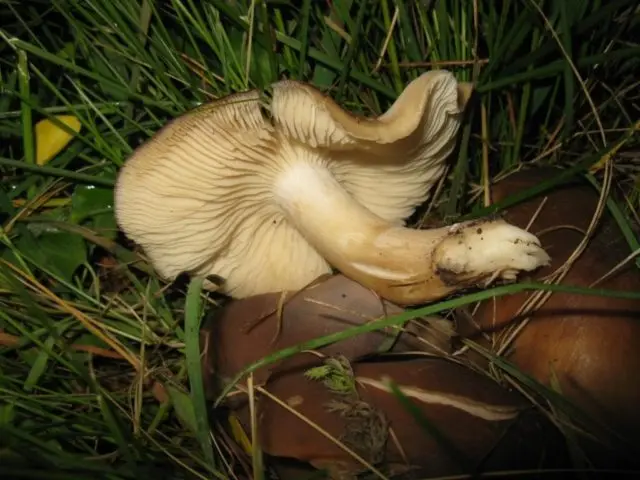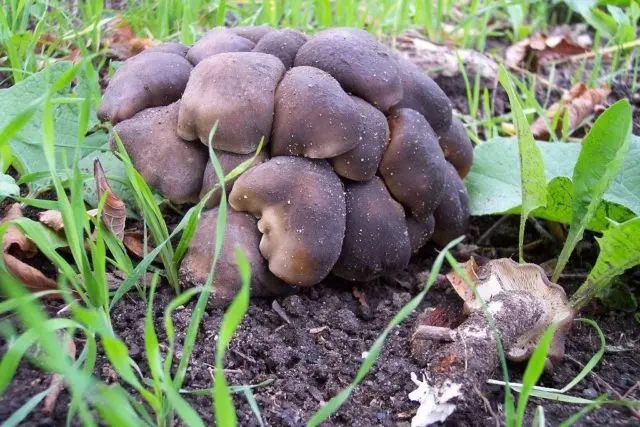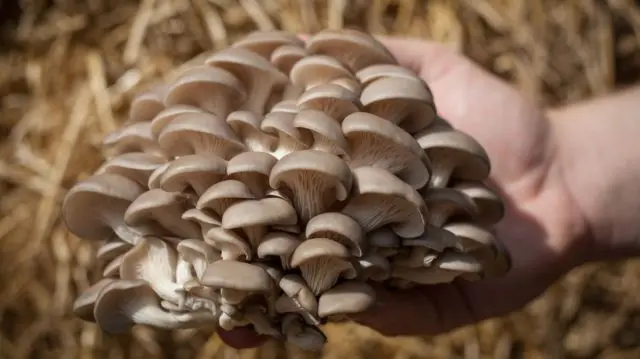Contents
Lyophyllum armored is a rare agaric mushroom of the Lyophyllic family, the genus Ryadovki. It is large in size, with a brown hat of irregular shape. Grows in large, tight groups on well-trodden ground. Its other name is the armored row.
What do lyophyllums look like
The shell cap grows up to 4-12 cm in diameter, less often up to 15 cm. In young specimens, it is spherical, opens as it grows, first becomes hemispherical, then prostrate, sometimes depressed. In mature it is uneven. The surface is smooth, with radial fibrillation. Old lyophyllums have wavy edges. The shade of the hat varies from light brown to almost black. From rain, humidity and sun, it gradually fades.
Spore-bearing plates have an average frequency. In young they are white, gray or gray-beige, in mature ones they are gray-brown. They may be ascending or descending.
The spore powder is whitish, light yellow or light cream. Spores are smooth, colorless, spherical in shape.

The height of the stem is 4-6 cm, it can reach 8-10 cm, the diameter is 0,5-1,5 cm. The shape depends on the growing conditions, it is often curved. Under natural conditions, it is usually central, sometimes slightly eccentric. If the fungus grows on dense, trampled soil or mowed grass, its length is from 0,5 cm. It can be eccentric, almost lateral or central. The leg is fibrous, closer to the cap is white or gray-beige, brownish below. Its surface is powdery. In mature specimens, the color of the stem is grayish-brown.
It has a dense, elastic, cartilaginous pulp that creaks when cut. The color is white, brownish under the skin. In mature specimens, the flesh is beige or gray-brown, elastic, watery. Lyophyllum has a mild pleasant mushroom smell.
Where do lyophyllums grow
This species grows in European countries, including Our Country, as well as in North America and northern Africa. Most often found outside the forest zone. It settles on lawns, in parks, in grass, on slopes, paths, clearings, embankments, next to curbs. It can be found in a meadow or in a field, less often in deciduous forests and on their outskirts.
Mushrooms grow together with the bases of the legs in several copies (from 10 or more), forming close groups. If they settled on a trampled area or mowed lawn, their colony resembles a dense shell.
Is it possible to eat lyophyllums armored
Lyophyllum is a conditionally edible species. Its palatability is low due to the dense and elastic pulp, therefore it is of no culinary interest.
False doubles
Lyophyllum crowded is one of the similar species. It grows in the same conditions, bears fruit at the same time. The main difference is in the plates. In crowded, they are weakly adherent or free. Other distinguishing features are rather conditional. The crowded has a lighter cap, the flesh is softer and does not creak. The mushroom is edible, much tastier than its relative, and when fried it resembles chicken.

The other doppelgänger oyster mushrooms. These are edible, widely known mushrooms. Outwardly, they are almost the same as the shell row, but differ in the place of growth. Oyster mushrooms do not grow on the ground, preferring wood, so in nature these two species cannot be confused. Of the external signs, the plates should be noted – in lyophyllum they break off abruptly, in oyster mushrooms they smoothly pass to the leg.

Lyophyllum smoky gray differs from its counterpart in the place of growth, it is found in coniferous forests, it has a lighter hat and a long leg. It is considered conditionally edible.

Collection rules
Fruits in autumn. You can collect it from late September to November.
Use
This mushroom is prepared in a universal way. A mandatory boil for 20 minutes is recommended. Then you can fry or stew.
Conclusion
Lyophyllum shell is a little-known conditionally edible mushroom that grows in close fused groups. It has a feature that distinguishes it from others: it can grow on densely packed soil and under curbs.









